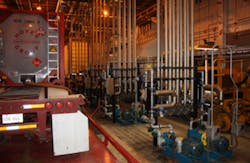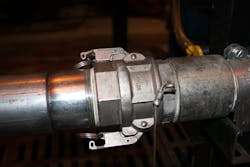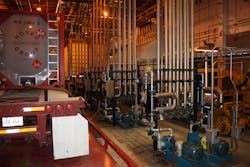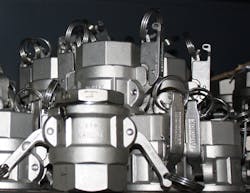When Edward Polen decided to change his careers as a pharmacist and chemical salesman in 1971 so that he could incorporate his own chemical packaging and distribution company in suburban Chicago he probably never envisioned that his E-M Company would experience days like Aug. 6, 2013. That’s when Polen cut the ribbon on a new 300,000-square-foot corporate headquarters and distribution facility in Pleasant Prairie, Wisconsin, a few miles north and 42 years after it all began in Polen’s garage.
How Do Ground-Verification Systems Work?
At some point, everyone has been reminded to “stay grounded,” or to not let success go to one’s head. In the world of chemical handling and transfer, staying grounded can have life-or-death consequences. Many of the chemicals that are shipped, pumped, transferred, loaded, and unloaded can be hazardous, meaning they must be properly contained and handled in the safest manner possible.
When chemicals are loaded into or unloaded from tank trucks and railcars, operators must take care that no electrical charges or sparks are produced, which could potentially ignite flammable materials.
The best way to do this is to install a ground-verification system at the loading/unloading dock. The ground verification system detailed in this article has been designed to provide visual verification that confirms a ground connection exists between the transport vehicle and the loading/unloading terminal.
Specifically, the ground-verification monitor is equipped with green and red LED lights. When a proper ground signal is detected, the green LED will light and a permissive signal will allow the loading rack to be operational. If a ground is not detected, or if it is lost, the red LED will light, indicating a non-permissive state that will shut down the loading operation.
“We are thrilled to be expanding our company by opening this new facility in Pleasant Prairie,” Polen told the audience at the dedication event, which included Wisconsin Gov. Scott Walker. “Although we have been doing business in Wisconsin since 1971, we are excited to have a physical presence with the opening of our state-of-the-art manufacturing/distribution facility and corporate headquarters. This expansion allows great opportunity for EMCO to grow.”
Thanks to Polen’s 40-plus years of determination and vision, EMCO Chemical Distributors Inc., the name that replaced E-M Co. in 1985, has grown into one of the 10 largest privately owned distributors, blenders, and custom packagers of industrial chemicals, specialty chemicals, and fine ingredients in the United States, and the 44th largest in the world, with more than $300 million in annual sales. The opening of the Pleasant Prairie facility was the culmination of a three-year design, engineering and construction process that was initiated with the purchase of a vacant facility that had previously been used as a resin and ink plant for the printing industry.
A Comfortable Connection
Working with a vacant facility was an advantage for EMCO’s design team that was headed by B.J. Korman, Vice President of Engineering, Stuart Levy, Vice President, Maintenance, and Mark Serdar, Facilities Maintenance Manager. The empty building was like a blank canvas on which they could imprint their hopes and dreams for the facility. The result is an operation that features 10 miles of stainless-steel pipe, 64,000 miles of wire, more than 1 million gallons of liquid-storage space, upward of 70 dedicated storage tanks, a 25-car railway siding, and side-by-side transport-truck and railcar loading/unloading docks.
However, a project of this scope could only be successful if exacting attention was paid to even the smallest of details. That’s one of the main reasons why EMCO decided that it would build its own hoses that would be used for loading and unloading at the docks, and color code them so that the proper hose would always be used to handle the appropriate chemical.
“We make our own hoses, mainly because of the optimized turnaround time. We make them ‘right now’ and get them out to the guys that need them,” said Serdar. “We make it any length we need and if the ends get wrecked, we just cut a foot off and put a new end on.”
A crucial component of the hose is the coupling at each end that is used to connect the hose to a truck or railcar and the loading/unloading rack. These couplings cannot leak and must be easy for the operator to handle, with no wasted time. For this task, EMCO has chosen Autolok and Kamlok Quick Disconnects from OPW Engineered Systems, of Lebanon, Ohio. The Autoloks feature OPW’s patented Twin-Kam feature that holds the adaptor more securely for increased protection against an accidental release. Kamloks are the world’s most popular cam-and-groove coupling thanks to their ease of use and reliably safe operation.
“The Autoloks and Kamloks are great, they keep the guys from accidentally popping the coupling on the hose,” said Serdar. “It’s also a very simple end to disconnect and reconnect with gloves on, so the simplicity of working that connection is important to the guys. We must have around 500 Autoloks and Kamloks in use. We do all of the pressure testing and each hose gets an ID tag so we can track that hose, and the Autoloks and Kamloks make the certification process that much easier.”
Making Up Ground
How Do Quick Disconnects Work?
Chemical-handling operations are only optimized when two critical operational parameters are successfully met—complete product containment and efficient time management.
For example, OPW’s Kamlok Quick Disconnect Coupling technology features a proprietary arm design to help prevent accidental releases and Spring-Ring to ensure proper position of finger rings for ease of operation.
Here’s how it works:
- Couple in any position
- Cam arms lock the coupler and adaptor together
This method of operation not only prevents accidental product spills, but also makes it easy to operate as the connections and disconnects are accomplished by simply closing and opening the two cam arms that lock into the mechanical groove around the circumference of the mating adaptor.
The result is a safe and easy-to-operate quick-disconnect coupling.
The best quick-disconnect couplings have also been designed to engage and disengage in the quickest (and safest) manner possible, holding the adaptor securely to protect against accidental product release.
Helping deliver the highest level of operator safety at the loading/unloading docks is a Model 8030 Ground Verification Monitor system from Civacon, based in Kansas City, Missouri. The 8030 ground system has been designed to visually confirm a ground connection between the truck or railcar and the loading terminal. If no ground connection is verified, the loading or unloading process will not be allowed to begin.
“The reason we chose the 8030 is that it gives a visual indication that something is grounded,” said Korman. “At EMCO, safety is of the utmost importance and that is one of the reasons why we chose the 8030 grounding package. Not only do you get a good visual of what’s going on, whether the vehicle is grounded, but we also tied it into our Programmable Logic Controller (PLC) so that a pump won’t start unless there’s a ground, and if it loses ground during a pumping operation, that pump will automatically turn off.”
The recommendation that EMCO use the OPW Engineered Systems disconnects and Civacon grounding package came from Joe Cervantes, Pump Sales Engineer for EMCO’s long-time equipment supplier, Anderson Pump & Process, Brookfield, Wisconsin.
“They were looking for the best type of coupling and ground-verification equipment and asked what we recommended, and we were quick to recommend OPW and Civacon,” said Cervantes.
It’s the Little Things
It’s often the little things that result in greater success, and EMCO Chemical Distributors has helped ensure the viability of its new facility by choosing top-of-the-line equipment and components, all the way down to the hose couplings and ground-verification equipment.
“The moral of the story is that if you team up with the right people and design systems per the requirements, you’re going to get a great result, and in our situation it has exceeded our requirements,” said Korman.
Dave Morrow is the Director of Product Management for OPW Engineered Systems, part of Dover Corporation’s OPW division. Mr. Morrow has 18 years of experience in the fluid handling industry and currently leads product development for the chemical and industrial unit of OPW. Mr. Morrow can be reached at [email protected].








